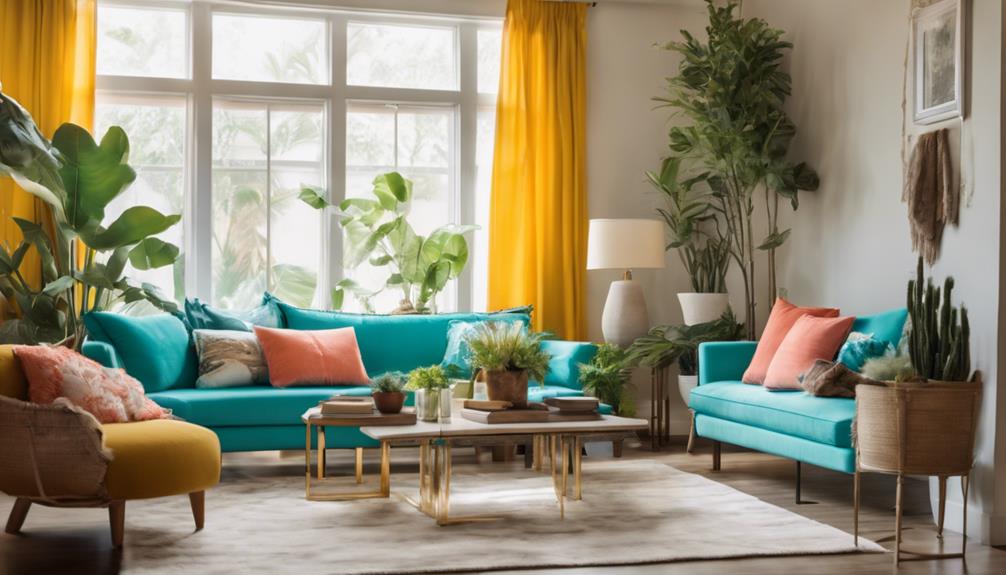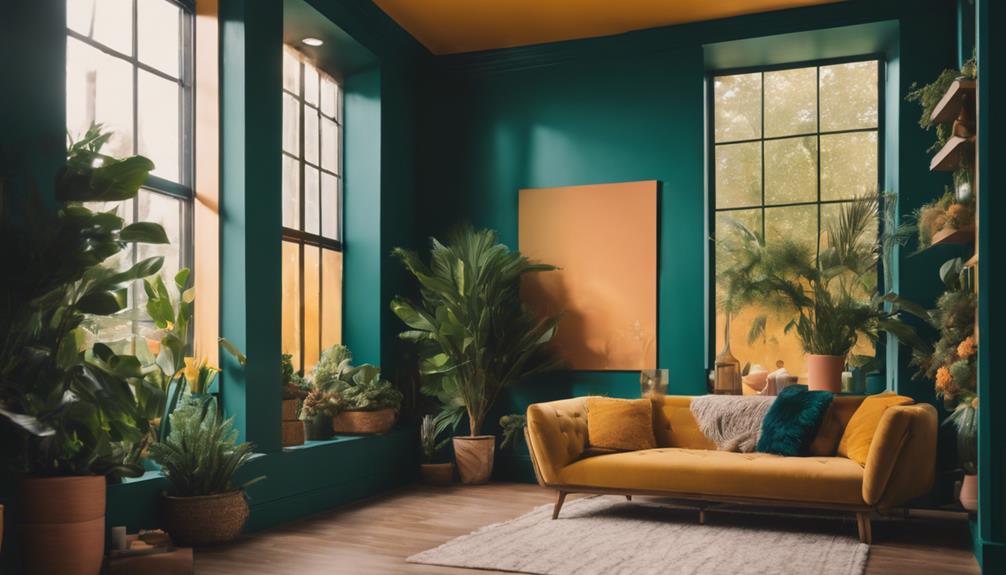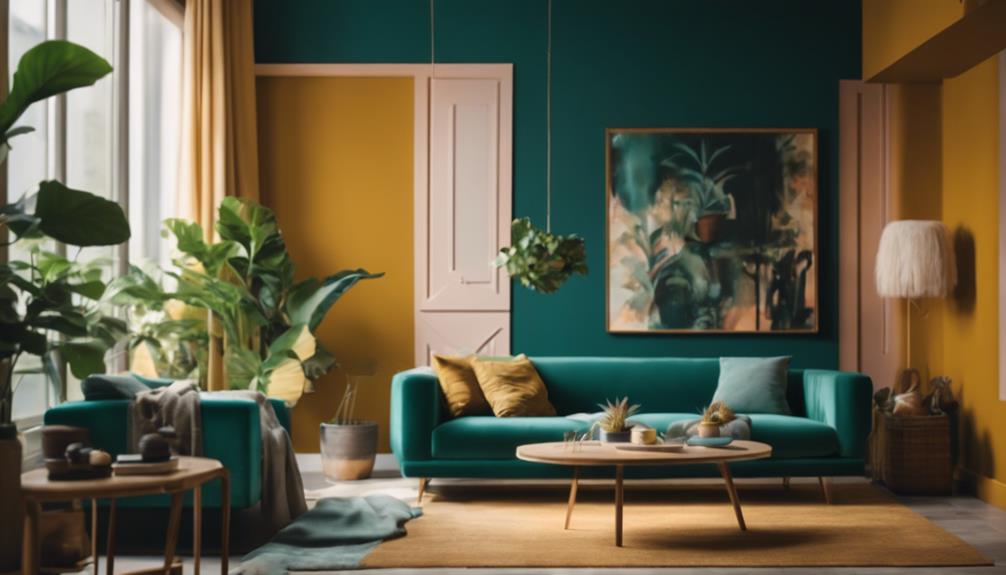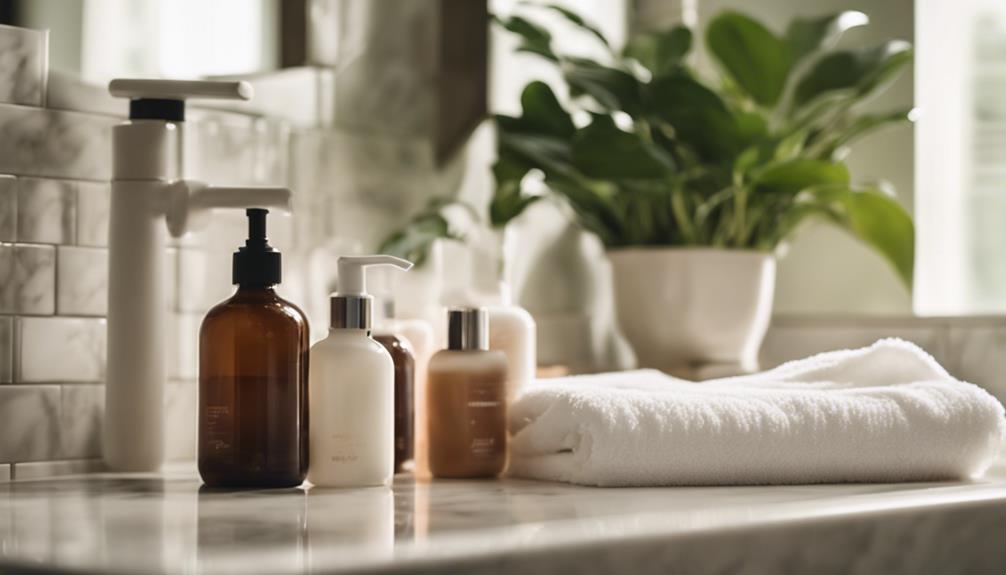Transforming your space with color harmony begins by choosing the right hues that complement the room’s purpose and the emotions you wish to evoke. Using light blues can help create a serene atmosphere in a bedroom, while deeper shades can bring sophistication to a workspace. It’s important to choose a dominant color that reflects your personal style and use neutral tones to balance out more vibrant hues. Accent colors play a crucial role in adding visual interest without overpowering the space. Don’t forget to declutter and arrange your space thoughtfully to showcase its key features. By staying informed about color trends and their effects, you can enhance the appeal and comfort of your home. For more tips on achieving the perfect color harmony, check out additional resources available.
Key Takeaways
- Identify the room's purpose to select colors that enhance its functionality and emotional tone.
- Choose a dominant color that reflects your personal style and sets a cohesive atmosphere.
- Incorporate neutral shades to balance vibrant colors and create visual harmony throughout the space.
- Use accent colors selectively to highlight focal areas without creating visual clutter.
Understanding Color Psychology

Understanding color psychology helps you tap into the emotions that different hues can evoke in your space.
For instance, lighter shades of blue like cornflower and cerulean create a calming atmosphere, perfect for bedrooms or relaxation areas. On the other hand, darker blues, such as royal blue and indigo, convey stability and intelligence, making them suitable for home offices or study areas.
Familiarity with these associations is essential when designing your environment, as it influences how you and others perceive the space.
Choosing Your Color Palette
When selecting your color palette, consider how different hues interact with one another and the overall mood you want to create in each room. Start by identifying the emotions you want to evoke.
Here are four tips to guide your choices:
- Determine the Room's Purpose: Think about how you use the space and select colors that enhance functionality.
- Choose a Dominant Color: Pick a primary hue that reflects your style and sets the tone.
- Incorporate Neutrals: Use neutral shades to balance vibrant colors and create a cohesive look.
- Test Samples: Experiment with paint swatches in different lighting to see how they transform the atmosphere.
Implementing Accent Colors

To enhance your color palette, implementing accent colors can add depth and interest to your space. Choose one or two accent colors that resonate with your overall theme; this keeps your design cohesive.
Use these colors sparingly to highlight specific areas, like a vibrant throw pillow or a piece of art. Consider complementary solid colors to anchor any patterns in your furniture, ensuring they don't overwhelm the room.
Remember, balance is key—too many accent colors can create visual clutter. Instead, let your chosen accents pop against a neutral backdrop, allowing them to draw the eye without competing for attention.
With thoughtful implementation, accent colors can transform your space, making it feel more inviting and dynamic.
Tips for Effective Staging
Effective staging transforms a space, making it more appealing to potential buyers and enhancing its overall marketability. To stage your home effectively, follow these tips:
- Declutter: Remove personal items and excess furniture to create an open, inviting atmosphere.
- Choose Colors Wisely: Select a cohesive color scheme that reflects the room's purpose; calming colors work well in bedrooms.
- Highlight Key Features: Use strategic color accents in areas like kitchens or bathrooms to draw attention.
- Create Balance: Guarantee a harmonious flow throughout the home by balancing vibrant colors with neutral tones.
How Can Color Schemes Create Harmony in a Space?
Color schemes can transform home with color schemes, creating harmony in a space. By carefully selecting and coordinating colors, a room can evoke a certain mood or atmosphere. Complementary colors can create balance, while analogous colors can offer a soothing and cohesive feel. Experimenting with different palettes can truly elevate a room’s aesthetic.
The Impact of Color Trends

Color trends can greatly influence your design choices, shaping the mood and appeal of your space. When you stay updated on these trends, you can better align your home with what's current and appealing.
For instance, if soft, neutral palettes are trending, you might consider incorporating calming shades that make your rooms feel inviting. On the other hand, vibrant hues can energize a space, especially in areas like kitchens or bathrooms.
Remember, balance is key; too much color can lead to chaos. By thoughtfully selecting one or two accent colors, you can create a cohesive look that feels modern and fresh.
Ultimately, embracing color trends can enhance both your home's aesthetic and its marketability.
Conclusion
By weaving together the threads of color harmony, you can craft a tapestry that speaks to your soul and invites others in.
Each hue you choose paints a story, transforming your space into a sanctuary that reflects your essence.
As you embrace the palette that resonates with you, remember that balance is your brushstroke—too much can muddle the masterpiece.
So, let your environment bloom with intention, and watch as it blossoms into a vibrant haven that energizes and inspires.









